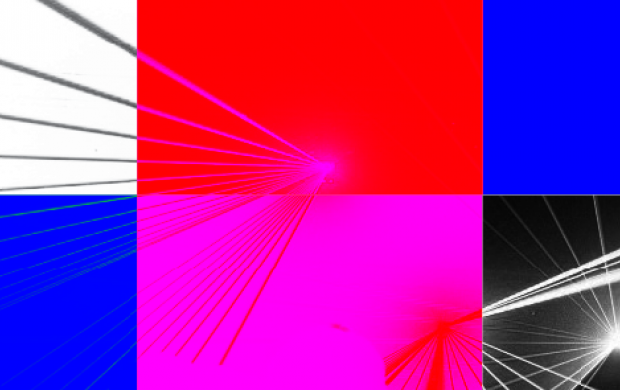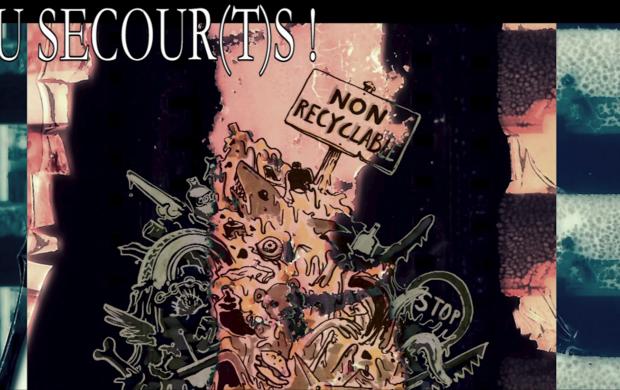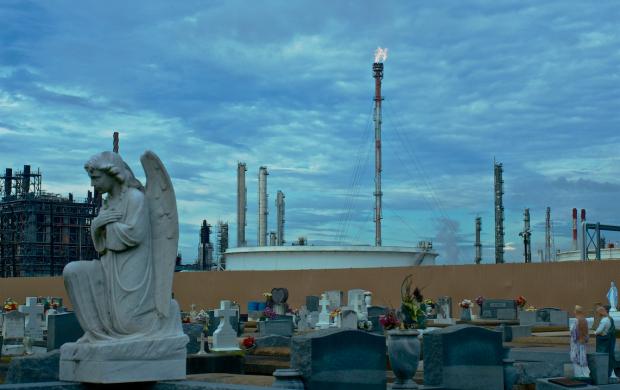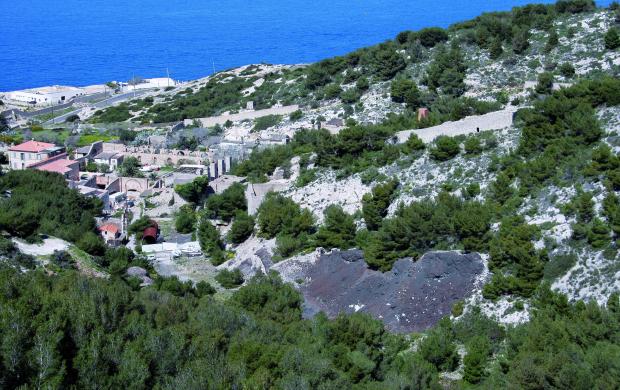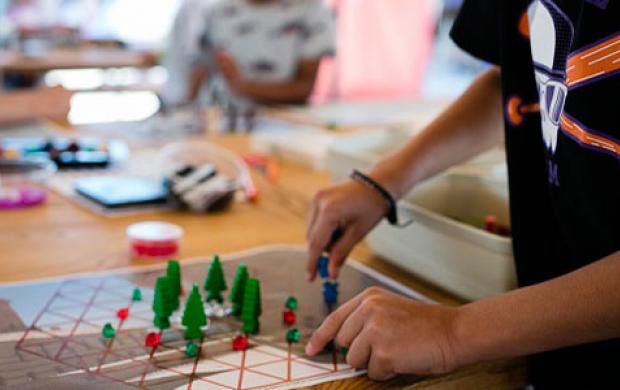Lives of Garbage
The Economy of Waste
|
From Wednesday 22 March 2017 to Monday 14 August 2017
Lives of Garbage—The Economy of Waste
The exhibition “Lives of Garbage: The Economy of Waste” invites you on a journey around the Mediterranean, to discover land- scapes, technologies, recycled and reused objects, and above all to meet the men and women who manage our waste, subsisting and often suffering, because of it. To do so implies examining their know-how, their living conditions, and the social relation- ships and conflicts affecting them.
Based on ethnographic investigations conducted in Turkey, Albania, Egypt, Italy, Tunisia, Morocco, and in south-east France (Marseille and its metropolis), this exhibition aims to raise public awareness about individual and collective waste management by exploring the ways that we collect, sort, repair, and trans- form refuse with the inventiveness that springs from necessity. Whether subject to diversions or high-tech treatments, waste gives shape to our landscapes and our social relations.
This exhibition encourages us to question our lifestyles and models of consumption and production through more than 450 objects, documents, installations, films, maps and diagrams from the collections of the Mucem and ethnographic museums like the Musée du Quai Branly and the Museo Guatelli
in the Parma region. It relies in particular on documents from the survey- acquisition campaigns initiated by the Mucem in 2014. Educational tools have also been designed especially for this exhibition including maps, waste classification tables, and models.
General commissioner : Denis Chevallier Ethnologist, general curator at the Mucem
Associate commissioner : Yann Philippe Tastevin Ethnologist at CNRS
Scenography and artistic direction : Encore Heureux, bkCLUB Architectes, Urbain, trop urbain
Graphics : Patrick Lindsay
Artists : David Degner, Lucy et Jorge Orta, Frank Pourcel, Lionel Sabatté et Nils Völker
Researchers : Bénédicte Florin, Jamie Furniss, Pascal Garret et Lucile Gruntz
Scientific committee : Sabine Barles, Tatiana Benfoughal, Gerard Bertolini, Sylvie Bredeloup, Delphine Corteel, Octave Debary, Jean-Baptiste Fressoz, François Galgani, Emmanuel Grimaud, Frédéric Joulian, Serge Latouche, Baptiste Monsaingeon et Yoann Moreau
Interview with Denis Chevallier, general curator of the exhibition
|
Mucem (M) |
Why has the Mucem chosen to address the question of waste management in this new exhibition? |
|
Denis Chevallier (DC) |
Through waste, we can examine our lifestyles, and our models of consumption and production. A museum of society like the Mucem can, in its own way, play an active role in the city. With this exhibition we hope visitors will become more aware that such daily and banal acts as consuming and discarding have consequences for the planet, and thus for us all. The exhibition Lives of Garbage: The Economy of Waste is distinctive in presenting a large number of objects recently acquired by the Mucem during a survey- acquisition campaign… |
|
M |
What will you present in this exhibition? How is it organised? |
| DC |
First visitors will come to realise that waste is everywhere. An autopsy of the dustbin-world, by way of intro- duction, will reveal the hidden, even doomed, aspects of our way of life. Things that we don’t necessarily want to see, and yet are there, not to be denied. In the next section we will ask how we got here? Indeed, this volume of waste with such grave effects on the environment is a recent event. Our grandparents, our great grandparents, surely did not have the same concerns about waste as we do, because there was so much less. To demonstrate this we can go back a bit, thanks to the ethnography collections, into the world that preceded the consumer society, prior to the massive distribution of plastic and the multiplication of packaging. Here, we display some objects that are rather unusual because they bear the marks of repairs, formerly a common practice. Alongside in contrast, plastic packaging evokes the current “everything-disposable” consumer society. |
| M | The third section of the exhibition is organised around simple actions: “picking up, collecting, transporting, storing, sorting”… |
|
DC |
Gestures that we will illustrate through a few objects and videos revealing the different modes of treating waste in the cities studied: it is in this section, for example, that we find the famous Cairo tuk-tuk, and a spectacular optical sorting machine on loan from the company Pellenc ST. The sorting process is central because it gives value to waste: once it has been sorted, it becomes secondary raw materials. Bales of cardboard, plastic or aluminium have a value set by global pricing. They are the subjects of a relatively large and lucrative trade, given the enormous quantities represented. In the following section, we provide examples of reuse and recycling. We will see for example, how a used tire can become a bucket, or how cans are transformed into aluminium ingots. In certain regions of the Mediterra- nean, reuse has increased considerably; as in the case of the second-hand clothing sector in Tunisia, which will be presented in a type of tent provided by one of the many partners of this exhibition: the community of Emmaüs Pointe Rouge. |
|
M |
However, the percentage of waste reused or recycled still remains relatively low… |
|
DC |
|
Exhibition itinerary
The Cairo tuk-tuk

A few months ago, this cargo-motorcycle was criss-crossing the streets of Cairo. Acquired by the Mucem
during a survey-acquisition campaign, it is now part of the collection of the museum and will be presented during the exhibition Lives of Garbage: The Economy of Waste.
Section 1 : Naming—measuring—classifying: tell me what you throw away!


Our waste shapes our environment on a global scale, and as such, provides a privileged vantage point to observe this transformation. Pollution—its nature, composition, dangerousness, circulation, and transformation—is presented in this section and the major categories of waste are quantified to provide an understanding of their origins and their distribution. In fact, domestic waste cannot compare with the quantities of waste produced by industry, agriculture and construction.
Equal space is thus given to those who are mobilizing to alert us to the pollution created by industrial discharges and emissions like at Fos-sur-Mer or the Étang de Berre in the Marseille region. In the Mediterranean, millions of tonnes of micro-waste particles are circulating and will contaminate all plant and animal life in the medium term.
Section 2 : Repairing—discarding: a brief history of waste



The economic and social history of waste is revisited through an ensemble of objects evoking the passage from a system where resources are scarce, and must therefore be maintained and recovered, to a model of consumption based on everything being disposable. The former economy of repair and reuse gave rise to specialisation, various small trades of the cities or the fields. Repaired or reused objects, from the ethnographic collections, are displayed in opposition to packaging of contemporary plastics to evoke this evolution, and the choices that have determined this acceleration of production.
Section 3 : Picking-up—collecting—transporting —storing—sorting: the movement of waste




This section begins in the streets with the most simple acts: sweeping, picking-up, followed by other essential actions: transport- ing, sorting, compacting. Objects from the collections and videos from ethnographic surveys reveal the technologies, manual and industrial, used to treat waste in the cities studied: Cairo, Istanbul, Casablanca, Marseille and its environs, Tirana, and Naples.
In this section, we discover unusual, and sometimes spectacular, objects like the hooks and tags of rag pickers, a devil acquired in Istanbul, a motorised tricycle, a paper-press used by the rag pickers of Emmaüs in the 1950s and an operating optical waste sorting machine on loan from the company Pellenc ST.
Sorting occupies a central place in waste management. It is through sorting that waste enters the global circuits of economic exchange and acquires value as a secondary raw material and thus as a new resource.
Section 4 : Re-employing—reusing—recycling: the waste workshop




Re-employment consists of giving a new life to what had been considered waste, either in the same context, as in the case of second-hand clothes, or by using it in a new way.
In the Mediterranean, re-employing includes important sectors of artisanal and industrial activities: weaving carpets from textile remains, drapery made from pieces of cut fabrics, like patchwork or appliqués, re-employment of used tires or cans, and plastic packaging. In certain regions of the Mediterranean re-employment has grown considerably, as is the case of the second hand clothing sector in Tunisia.
Recycling involves treating waste as a secondary raw material that can be put to new use. The exhibition presents the recycling chains in Cairo and those of electrical and electronic waste in France.
Section 5 : Reducing—burying—composting— incinerating: what are the solutions for a “zero waste” society?



Re-employment consists of giving a new life to what had been considered waste, either in the same context, as in the case of second-hand clothes, or by using it in a new way.
In the Mediterranean, re-employing includes important sectors of artisanal and industrial activities: weaving carpets from textile remains, drapery made from pieces of cut fabrics, like patchwork or appliqués, re-employment of used tires or cans, and plastic packaging. In certain regions of the Mediterranean re-employment has grown considerably, as is the case of the second hand clothing sector in Tunisia.
Recycling involves treating waste as a secondary raw material that can be put to new use. The exhibition presents the recycling chains in Cairo and those of electrical and electronic waste in France.
Section 6 : Getting involved: Citizens rising to the challenges of waste management
Waste is the subject of mobilizations of all kinds: technicians, scientists, but above all, politicians and citizens. The ecoballs of Cam- pania, the rubbish that obstructs the streets of Beirut, the Roma of Tirana doomed to living off the waste of the city are all examples of the struggles generated by the often scandalous management of waste.
This section also highlights exemplary actions to give visitors the desire to get involved. Indeed, populations often mobilise to clean a street, a beach, and also to discard less by producing and consuming less.
Scenography and artistic direction




The scenography is designed to be dismantled and reused at the end of the exhibition in order to generate the least waste possible.
Large panels of fibreboard, the materials usually used at the Mucem for the gallery walls, are left untreated with neither coat- ings nor paint. The screws are visible, making the dismountable nature of the walls obvious. Only the panels bearing the titles of the different sections of the exhibition are engraved with a design juxtaposing contradictory pictograms (toxicity, radioactivity, sort- ing, recycling...) to accompany visitors in their discovery of the multiple issues related to the treatment of our waste.
The exhibition intentionally features dull tones, with the light brown of fibreboard, the grey of carton, on which the texts and graphics are printed. The bottoms of the showcases and alcoves are in white to emphasize and highlight the collections of objects.
The itinerary is punctuated by a series of verbs in the infinitive, written in cut-out letters on the gallery walls. From Naming to Collecting, from Reducing to Burying, the content presented is organised in a linear fashion, following the principal actions included in the chain of operations of waste management, highly technical and yet always human.
For the final section the plateau opens onto the landscape, the horizon enters into the exhibition, and with it, the omnipresence of the Mediterranean. This last part is structured around authentic architecture, created especially to accommodate three investiga- tions into particular sectors. The sorting of second hand clothing in in Tunisia is depicted under a tent of multi-coloured T-shirts, the process of recycling in Egypt is illustrated in a hut made of plastic braids, while the impasse of ecoballs in Italy is narrated in the sarcophagus of a pyramid with steps, under the same black
tarpaulin that covers these mountains of garbage situated in the landscape of Campania.
The entrance and exit of the exhibition are each accompanied by an artistic installation that leaves open the many questions assailing those who dare to look at the many lives of garbage.
Scénographie et direction artistique : Encore Heureux, bkCLUB Architectes, Urbain, trop urbain
Encore Heureux (Still happy)
Founded in Paris in 2001 by Nicola Delon and Julien Choppin, Encore Heureux is an architectural firm that practises in the fields of architecture, design, and artistic installation. A laureate of the Nouveaux Albums des Jeunes Architectes (New Albums by Young Architects)—distinction of the Ministry of Culture—in 2006, it has produced several cultural and tertiary facilities, both public and private, (concert hall, cinema, museum, centres of innovation). In parallel, Encore Heureux designs sets, games, furniture, books and exhibitions. As a generalist architectural practice, the agency was distinguished in 2014 by serving as scientific commissioner for the exhibition Matière Grise, at the Pavillon de l’Arsenal in Paris, and as authors of a collective volume on the reuse of construction materials. In 2016, Sébastien Eymard joined the adventure as a third associate and the team has grown to include today some fifteen designers from diverse backgrounds.
bkCLUB Architectes
Founded in 2016 by Clotilde Berrou and Marc Kauffmann, bkclub Architectes is an architectural studio. After 15 years of practice with other agencies on mega-buildings (Friche de la Belle de Mai
& Centre National des Arts du Cirque), they currently develop projects, starting from the singularities of heritage and context. They seek an attentive and benevolent perspective to find avail- able resources, sources of narratives, and construction materials. This implies considering the places, sometimes disinherited, see- ing there ordinary rites, listening to the stories and frustrations, like the hopes, so that at each level of intervention, from detail to building, the project finds its fertile and unexpected soil.
The collective Urbain, trop urbain
Bringing together for this occasion, Matthieu Duperrex, Claire Dutrait and François Dutrait, the collective offers to grasp the current metamorphoses of the city and the world through reso- lutely subjective artistic and cultural practices, whether poetic or reflexive. Since 2010, through its engineering of writing, the col- lective accompanies researchers in particular in the “translation” of their work to serve a wide audience.
Publication

De l'économie des déchets
Le catalogue de l'exposition, sous la direction de Denis Chevallier et Yann-Philippe Tastevin
All activities and events (in French)
Downloads
Dossier pédagogique .pdfPartners and sponsors
With the generous support of: SUEZ, ADEME and Pellenc ST
This exhibition takes place in collaboration with the National Folk Museum in Seoul 2.
In partnership with : UshuaïaTV, La Croix, Europe 1




